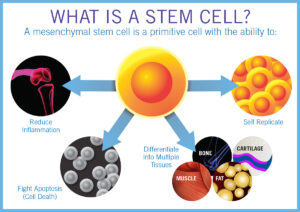Stem cell therapy has quickly become one of the most exciting areas of medical research, with the potential to change the way we approach treatment for a variety of conditions. From treating injuries and chronic diseases to offering solutions for conditions once considered untreatable, stem cell therapy is a beacon of hope for many.
What is Stem Cell Therapy?
Stem cell therapy is a type of regenerative medicine that uses stem cells to treat or prevent diseases and conditions. Stem cells are unique because they have the potential to develop into many different types of cells in the body. This regenerative ability allows them to repair or replace damaged tissues and organs, making stem cell therapy an attractive solution for a variety of health issues.
The two most common types of stem cells used in therapy are:
- Embryonic Stem Cells: Derived from early-stage embryos, these cells have the ability to differentiate into virtually any type of cell in the body. However, their use raises ethical concerns, as harvesting them requires the destruction of an embryo.
- Adult Stem Cells: These are found in adult tissues such as bone marrow, fat, or the blood. Adult stem cells are more limited in their differentiation potential but are still valuable for certain therapies. These cells are more commonly used in clinical settings and offer fewer ethical dilemmas.
- Induced Pluripotent Stem Cells (iPSCs): These are adult cells that have been reprogrammed in the laboratory to behave like embryonic stem cells. iPSCs have the potential to become any cell type, offering a less controversial alternative to embryonic stem cells.
How Does Stem Cell Therapy Work?
Stem cell therapy works by utilizing the unique ability of stem cells to regenerate and repair damaged tissues. The process typically follows these general steps:
- Harvesting Stem Cells: Depending on the condition being treated, stem cells are harvested from the patient (autologous therapy) or a donor (allogeneic therapy). The harvesting method depends on the type of stem cells used—whether from bone marrow, adipose tissue, or through laboratory reprogramming.
- Culturing and Processing: In some cases, stem cells are cultured and expanded in a laboratory to increase their numbers. These cells may also be processed to enhance their effectiveness before being reintroduced into the patient.
- Injection or Transplantation: Once prepared, the stem cells are either injected into the patient’s body or transplanted into the damaged tissue. The cells then begin their work by differentiating into the necessary cell types and repairing the injured or diseased tissue.
- Regeneration: Once the stem cells integrate into the affected tissue, they can help regenerate the damaged cells, promote healing, and restore normal function. Over time, this process can significantly improve symptoms and even reverse the effects of certain diseases or injuries.
Applications of Stem Cell Therapy
Stem cell therapy has shown promise in treating a wide range of conditions, including:
- Chronic Conditions and Degenerative Diseases: Stem cell therapy is being investigated as a potential treatment for diseases such as Parkinson’s disease, Alzheimer’s disease, and multiple sclerosis. The regenerative potential of stem cells offers the hope of reversing damage to the nervous system, which is typically beyond repair with traditional treatments.
- Spinal Cord Injuries: Spinal cord injuries often result in permanent damage to the nerves, leading to paralysis. Stem cell therapy holds promise in stimulating the regrowth of nerve cells and improving function in patients with spinal cord injuries.
- Cardiovascular Disease: Stem cells are being used to repair damaged heart tissue caused by heart attacks or heart failure. In some cases, stem cell therapy has led to the regeneration of heart muscle, improving heart function and helping patients with heart disease lead more active lives.
- Orthopedic and Joint Injuries: Stem cell therapy has been used to treat conditions such as osteoarthritis, tendon injuries, and cartilage damage. By injecting stem cells into the damaged area, the body can regenerate the tissues, potentially avoiding the need for surgery.
- Cancer Treatment: Stem cells are also being used in certain types of cancer treatment, particularly hematopoietic stem cell transplantation for patients with leukemia and other blood cancers. This therapy helps rebuild a patient’s blood cells after chemotherapy or radiation.
- Skin Regeneration: Stem cells are being investigated for their role in skin regeneration, especially in treating severe burns or wounds that don’t heal properly. The ability of stem cells to regenerate new skin tissue has shown significant promise in improving the healing process.
The Benefits of Stem Cell Therapy
- Regenerative Potential: The most compelling advantage of stem cell therapy is its ability to regenerate and repair damaged tissues, potentially reversing the effects of conditions that were once thought incurable.
- Minimally Invasive: Many stem cell treatments can be administered with minimal invasiveness, often through injections or small incisions, making recovery faster and easier for patients compared to traditional surgery.
- Personalized Medicine: Stem cell therapy has the potential to offer personalized treatments, particularly when using the patient’s own stem cells. This can reduce the risk of rejection and improve the overall success of treatment.
- Long-Term Benefits: Stem cells can continue to work in the body over time, offering long-term healing and relief, which is not always achievable with traditional medications or therapies.
Challenges and Ethical Considerations
Despite its promise, stem cell therapy also presents several challenges and ethical concerns:
- Safety and Efficacy: Although stem cell therapy holds great potential, it is still in the experimental phase for many conditions. Researchers are working to ensure that the treatments are both safe and effective before they can become widespread.
- Ethical Concerns: The use of embryonic stem cells raises ethical dilemmas, as it involves the destruction of human embryos. This has led to ongoing debates over the moral implications of using these cells in medical treatments.
- Regulatory Challenges: Because stem cell therapies are relatively new, they are subject to strict regulation by health authorities, which can slow down the process of bringing new treatments to market. Additionally, unregulated stem cell clinics sometimes offer treatments that are not backed by scientific evidence, posing potential risks to patients.
- Cost: Stem cell therapies can be expensive, making them inaccessible to many patients. Insurance coverage for stem cell treatments is also limited, further complicating access to these potentially life-changing treatments.
The Future of Stem Cell Therapy
While stem cell therapy is still a developing field, the future looks bright. Ongoing research continues to uncover new ways stem cells can be used to treat a variety of conditions, and breakthroughs in technology may further enhance their effectiveness. As science continues to evolve, stem cell therapy could become a cornerstone of modern medicine, offering solutions to some of the most challenging medical problems.
Conclusion
Stem cell therapy represents a remarkable leap forward in the treatment of many diseases and injuries, with the potential to transform the way we approach healing and regeneration. From offering hope for patients with degenerative diseases to providing cutting-edge solutions for injuries and chronic conditions, stem cell therapy has the power to change lives. While challenges remain, continued research and advancements in this field are likely to bring even more promising treatments in the near future. If you or a loved one is considering stem cell therapy, it’s important to consult with a healthcare professional to understand the potential benefits, risks, and available options.

